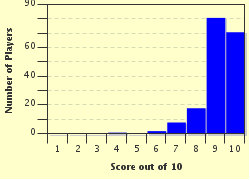Quiz Answer Key and Fun Facts
1. To which of the following continents are snowy owls native?
2. Why is the horned owl called a horned owl?
3. Most species of owls are birds of prey. What is another word for a bird of prey? Hint: Think of dinosaurs.
4. What part or parts of an owl's body does it use to capture its prey?
5. Almost all owls are nocturnal. What does the word nocturnal mean?
6. The mottled wood owl can camouflage itself to hide from predators. It does this by blending in with the bark of a tree. Which of the colors below is the mottled wood owl most likely to be?
7. What shape do owl eggs mostly come in?
8. Where did the burrowing owl get its name from?
9. Which of the following conditions is NOT good weather for an owl that wants to hunt?
10. There is a species of owl on some Pacific islands called the fearful owl. Where did they get their name from?
Source: Author
Joepetz
This quiz was reviewed by FunTrivia editor
NatalieW before going online.
Any errors found in FunTrivia content are routinely corrected through our feedback system.


